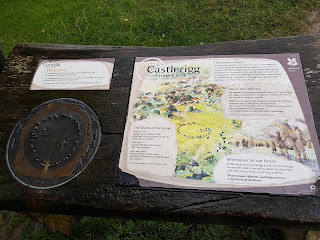This morning our plan of eggs and bacon for breakfast went out the window when no one surfaced from bed until after 7 am. Another sleep-in, what were we thinking!
 We headed up through Penrith, stopping for a wander of the town centre and shops, then along the A69 out to Haltwhistle. We walked through the main street and explored the centre of town, doing a little more shopping!
We headed up through Penrith, stopping for a wander of the town centre and shops, then along the A69 out to Haltwhistle. We walked through the main street and explored the centre of town, doing a little more shopping!
From here we headed out along the B6318, which runs basically parallel to Hadrian's Wall. Hadrian's Wall is a defensive fortification in the Roman province of Britannia, begun in AD 122 during the reign of the emperor Hadrian. Spanning 73 miles, it ran from the banks of the River Tyne near the North Sea to the Solway Firth on the Irish Sea, and was the northern limit of the Roman Empire.
Housesteads Roman Fort is the remains of an auxiliary fort on Hadrian's Wall. The fort was built in stone around AD 124, soon after the construction of the wall began in AD 122. Its name has been variously given as Vercovicium, Borcovicus, Borcovicium, and Velurtion, with the modern name taken of the 18th century farmhouse Housesteads which stands near the site.
At Housesteads we were able to wander through the ruins, including the barrack blocks and the hospital. We admired the stunning panoramic views from the ancient fortress, you could definitely tell why the Romans would have built on the hill here. The interactive museum showcases objects once belonging to Roman soldiers, and the mini-cinema took us through a journey of the life and times at the fort.
Having Granny Nanny's Disability Parking meant that we could drive right up to the museum and to the site of the fort, instead of having to brave the weather and hike up the hill. The cows didn't really want to share the road, but we were happy to wait for them to move considering the high winds and rain pelting down outside our nice toasty warm car. Once at the top of the hill we walked the museum and then Mum and I braved the weather to explore the ruins.
 |
| Driving through the Cows |
 |
| The Museum |

 |
| Right before she slipped on her bum! |
Having been blown away almost literally, and Mum attempting to slide down the hill instead of walking back, we returned to the car a little bit wetter than when we departed. We drove back down the hill, once again having to wait for the cows to allow us to pass, and back onto the road.
Once again we were driving along the top of the country side as we headed into Alston. Though the rain made it quiet difficult to see, the clouds and mist rolling over the hills was a beautiful site. Passing Langley Castle along the way, we decided not to stop for a cup of tea and just took a picture instead. We eventually made it to Alston, a quaint little town in the middle of nowhere, before we headed down the other the mountain, literally!
 |
| Alston Town Centre |
 |
| Hartside Summit |
We made it down the mountain and to Penrith earlier than we expected to so we headed out to Keswick to finish the afternoon. When we arrived it was pouring with rain. Us, not realizing this rain was like our rain at home, coming and going every 5-10 mins just walked through it. Mum and Granny Nanny had umbrellas and I just trusted my Kathmandu jacket to keep me dry. It did, but my jeans failed the test.
On our way home, we drove past a sign for Castlerigg Stone Circle. The best attractions you see are always the ones not planned and this did not disappoint. Following the signs and having no idea where we were going. Granny Nanny in the back seat must have asked at east twice "how much further on these windy horrible roads?" We overshot the parking area and it being a single laneway with stone walls on either side and minimal passing places, we reversed back up the hill to pull up on the side of the road next to a seemingly normal row of trees. Once you got behind those trees however was a beautiful scene. The stones were at the top of the hill over looking the valley.
It is not just the location that makes Castlerigg Stone Circle one of the most important in Britain; considered to have been constructed about 3000 bc, it is potentially one of the earliest in the country. Although there are more than 300 stone circles in Britain, the great majority of them are Bronze Age burial monuments (dating from approximately 2000–800 bc) containing cremations in central pits or beneath small central cairns. By contrast, their Neolithic forebears, such as Castlerigg, do not contain formal burials. The Neolithic stone circles also differ from those of the later Bronze Age in their generally larger size and often flattened circular shape – as is found at Castlerigg – comprising an open circle of many large stones. Castlerigg has not been extensively excavated, and it is therefore not known exactly what might be preserved beneath the surface.
The precise function of these early circles is not known, but their importance possibly centred on their large internal areas with their formalised entrances. Sites such as Castlerigg were undoubtedly important meeting places for the scattered Neolithic communities, but whether as trading places or as religious centres, or even both, is not known.















No comments:
Post a Comment